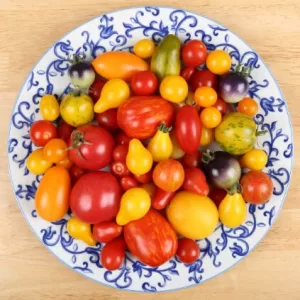Tomato: The Red Flavor of Health and Versatility
An Exploration of the Numerous Varieties of the Fruit that Conquered Kitchens Around the World
The tomato is more than just a simple ingredient; it’s a global culinary icon.
This article unveils the journey of the tomato from its humble origins to becoming one of the most cultivated and beloved fruits in the world. We celebrate its numerous varieties, each with its distinct nutritional profile and specific culinary applications.
Origins and History
Native to the Americas, the tomato was first domesticated in Mexico, and despite initially being considered poisonous in Europe, it transformed into a staple of Mediterranean cuisine. Its spread around the world is a testament to its universal appeal. In Italy, it is affectionately called “pomo d’oro” or “golden apple,” a homage to the early European tomatoes of golden yellow coloration and to its culinary value compared to gold.
Varieties and Culinary Characteristics
From the robust Beefsteak to the delicate cherry tomato, each tomato variety offers a microcosm of possibilities.

The Meaning of Colors
The color of a tomato often indicates its flavor profile – the reds are balanced between sweetness and acidity, the yellows and oranges tend to be sweeter and less acidic, while the purples and blacks offer complexity and smoky or earthy notes.
Moreover, the color of tomatoes reflects the different phytonutrients they contain.
For example, orange and yellow tomatoes have high levels of beta-carotene, while purple and black tomatoes are rich in anthocyanins.
Let’s explore some of them
Beefsteak Tomato: Ideal for sandwiches and salads, where their juicy texture and balanced flavor can really shine.
Cherry Tomato: Perfect for snacks, salads, or as a colorful and flavorful touch in baked dishes.
Roma Tomato: Less watery and with fewer seeds, it’s ideal for sauces and preserves.
Heirloom Tomato: These ancient varieties are appreciated for their diversity of flavors and colors, enriching dishes with their uniqueness.
Grape Tomato: Sweeter and firmer, they are a popular addition to salads or as a healthy snack.
San Marzano Tomato: The gold standard for tomato sauces due to their dense flesh and rich, sweet flavor.
Green Zebra Tomato: With its green skin and yellow stripes, it offers a slightly tart flavor perfect for salads and cold dishes.
Yellow Tomato: Less acidic, these tomatoes bring a gentle sweetness to any dish.
Purple/Black Tomato: They have deep colors and an almost smoky flavor.
Oxheart Tomato: With a shape resembling a heart, they are huge and have an intense flavor.
Orange Tomato: This variety is a delicious option for those looking for a tomato with low acidity.
White Tomato: Yes, there are white tomatoes! They have a very mild flavor and can be an interesting surprise in dishes.
Nutritional Value
The tomato is a source of vitamin C, potassium, folate, and vitamin K, as well as lycopene, an antioxidant with potential benefits in reducing the risk of heart disease and cancer.

Conclusion
The tomato, called “pomo d’oro” in Italy and its numerous colorful varieties are cherished for their vast range of colors worldwide, being a culinary gem.
Each variety brings its own story, flavor, and nutritional value to the table.
Cooking with a wide palette of tomatoes is not just an adventure for the palate but also a feast for the eyes, making each dish a work of art that is tasty and healthy.
By understanding and appreciating the diversity of the tomato, we reaffirm our love for this versatile fruit that continues to be a pillar of global gastronomy.